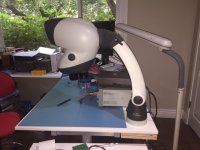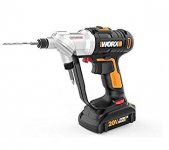I desperately want a microscope at home, but recoil at the used price of anything I'd regard as decent (ie anything that I've used professionally).
I found a used Vision Engineering "Mantis" eyepieceless stereo microscope on eBay, paid USD 1200 + shipping. It was very favorably reviewed on Dave Jones's EEVblog here
Here's a photo of it, bolted to a workbench in my home lab. If you look closely you can see the stack of two slabs of 3/4 inch plywood I added underneath the tabletop, for extra stiffness. The scope base is bolted to the tabletop + stiffeners.
_
Attachments
My Metcal soldering iron.
Agreed mine is absolutely wonderful too.
A second $29.00 battery drill.
Now two drills the same and much less bit swapping.
I should have done this decades ago.
Dan.
If anyone does a lot of that then consider this Switchdriver
Attachments
Oooh! What's a Mapp gas torch?
I actually use a propane torch that I once would have used for soldering house wiring junctions... Best? Probably not, but it does feel -very- DIY.
MAPP gas was a proprietary blend which burned hotter than propane but not as hot as acetylene. It seems the formula has changed over the years; it may be whatever hot-burn residual gas they find in the refinery. "Hot" gasses in bottles need a way to control spontaneous reaction, and odorless gasses have odors added, so the "fish" smell of some MAPP may not be true for all.
Propane is a nice warm flame. It heats my house, and does not burn-up the furnace passages.
Acetylene burns much hotter, and hotter still with pure Oxygen. Classic for steel welding. But bottled acetylene will explode violently (Prest-O-Light factory blew up so often they were run out of town). The tanks are filled with stone-foam and acetone, costly and still touchy.
MAPP falls in the middle. When you need higher temp than propane but prefer not to mess/invest in acetylene. Very much a niche product so you pay for that. It will burn in air in a plain "propane torch", or hotter in Oxygen. Of course bottled Oxy is another hassle. There used to be a "pill" which burned Oxy-rich and was used in a $40 MAPP/Oxy homeowner torch. (Now a $69 kit with bottled Oxygen, Bernzomatic OX2550 kit. Probably those pills were deemed too dangerous to ship.)
Soldering house wires is not done today (I see it in old books). I do not think it is forbidden. I have heard that in a violent short, the molten solder fling-around does added damage. Obviously the main thing is that Wire-Nuts are so much less trouble to install and (if done right) trouble-free even at brutal current. I soldered a 50 Amp feed wire in my tractor's new fuse-box.
Last edited:
Twin Power Drills
For me, the tools I can't live without has to be my pair of twin power drills. I use them almost every day and can always rely on them to do the job.
For me, the tools I can't live without has to be my pair of twin power drills. I use them almost every day and can always rely on them to do the job.
Not useful to me, I need long drivers.If anyone does a lot of that then consider this Switchdriver
I use the longest phillips bit I can find, and long length allen keys.
I fix a lot of mechatronic modern stage lighting and they are full of hex screws and phillips screws, swapping drills is the quickest and easiest.
I find the elcheapo ($29.00) drills are the best...light weight and the clutch goes down to low values accurately which is important in this case.
In 'clean room' workshop conditions these cheap drills last pretty much forever.
Dan.
And I thought I was the only one crazy enough to cut sheet aluminum on a table saw. My shop teacher about had a cow when I showed him these pictures.
I've used a router with carbide bits on low speed and it works a charm. A sharp wood plane will also work.
They are indeed fine devices. I just wish the damned thing had a pilot light - I've accidentally left mine turned on a time or three because you can't tell at a glance that it's on (the power supply sits up on a high bench shelf and without standing and purposefully looking, the display is hard to read and its being on or off is not readily obvious). One of these years I'll open it up and put some sort of indicator in it...
-Pat
Having posted in this thread finally motivated me to put a power indicator into the WD-1. I scrounged up an old push-in neon indicator that came from Rat Shack some time in the early to mid '80s, some 0.187" stacking fastons, and a few inches of wire and shrink tubing to lengthen the leads on the pilot light. Opening the power supply showed a bit of space just above the power switch, so a few moments with the drill was all it took to install the indicator. The fastons go onto the transformer primary terminals, and the old mains lines connect to the piggybacks.
This should make it more readily apparent when it's on, and help prevent me from leaving it in that state when it shouldn't be.


-Pat
MAPP gas was a... <snip!>
Soldering house wires is not done today (I see it in old books). I do not think it is forbidden. I have heard that in a violent short, the molten solder fling-around does added damage. Obviously the main thing is that Wire-Nuts are so much less trouble to install and (if done right) trouble-free even at brutal current. I soldered a 50 Amp feed wire in my tractor's new fuse-box.
I was working as a sparky's apprentice at one stage, not too long ago, and we used both soldered joins and 'bluepoints' which aren't wire nuts; more like an insulated cylindrical chamber with a grub screw. You could get upto 4 2.5mm cables into each one of these, so big junctions we typically soldered instead, wrapped in tape, then installed into a junction box (basically just a plastic enclosure). The common wisdom was that this was overkill but best practice.
I find it interesting and perplexing that there's such a variety of standards through the western world on something as simple (and relatively recent) as house wiring. The goals and risks are the same everywhere, yet there's such a proliferation of approaches and risk/benefit. Even down to training - Sparkys here have to understand everything required to be a full on electrical fitter, even if they go on to just be a 'housebasher'; 4 years in total to qualify.
Now wiring I saw when in south africa is a whole different ballpark...
I had time to kill in Bankok so I went for a walk around the markets area near to the airport.
It seems that standard practice was to join random lengths/colours of wire in series, wrap one end around street wires, and route the combos in through a window......free energy ?.
My question is how they manage to make the connection high above the street and far out from the building ?.
Dan.
It seems that standard practice was to join random lengths/colours of wire in series, wrap one end around street wires, and route the combos in through a window......free energy ?.
My question is how they manage to make the connection high above the street and far out from the building ?.
Dan.
Last edited:
....'bluepoints' which aren't wire nuts; more like an insulated cylindrical chamber with a grub screw.....
....I find it interesting and perplexing that there's such a variety of standards through the western world on something as simple (and relatively recent) as house wiring....
Grub-screw connectors are semi-universal, but 'bluepoint' seems to be AU-only, and not even current there?
Single Screw and Double Screw Connectors, BP's, Connector strips | Online Electrical Supplies
The one I think you mean comes in black and clear.
Tommy was collecting electric bills long before there were automobiles. Think how many different types of carburetors have come and gone in 110 years. The electric business is very conservative. Products linger 50 years. (I identified a product which has not changed in 102 years.) Work trucks are full, we don't need multiple products for the same job. If a product gets traction enough to dominate, all other products are blocked until they come up with a Real Improvement (and are savvy enough to carry-through). And these leaders are different in every land. WireNuts replaced twist-and-tape in my lifetime; Wagos are fully legal but not widely used except the ones that come free with Halo fixtures (and some guys throw those out). Split-Bolts are crude bad connections, but need no tooling and can be done across a wide range of conductors, so there's a bucket in every truck instead of proper crimp or grub types.
'Bluepoint' was the brand name of the originals and 'BP connector' has become a standard name like so many other items in Aussie parlance.
Dan.
Or, even more aussie, a 'bluey'
- Status
- This old topic is closed. If you want to reopen this topic, contact a moderator using the "Report Post" button.
- Home
- Design & Build
- Equipment & Tools
- What tool do you wish you had bought sooner?

